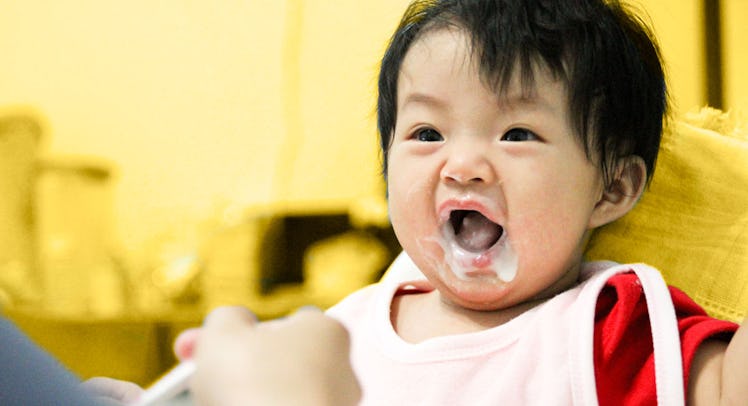Why New Eaters Bite Themselves And How to Help
Kids new to finger foods are fighting reflexes, but parents can help them get a handle on their tongues

Experienced eaters don’t generally bite their tongues and fingers—though, when it happens, it’s a terrible reminder of the ever-present potential for excruciating pain in even the most pleasurable moments. Adults don’t have to think about not biting their own hands or the insides of their mouths when they eat, because chewing and chomping safely is reflexive. Not so for babies. And as toddlers transition from breastfeeding to finger foods, the victims can often be their actual fingers.
Children accidentally biting their fingers is “really common, especially between 6 months and 12 months of age,” explains Melanie Potock, pediatric feeding coach and author of Raising a Healthy Happy Eater. “Learning to eat is a developmental process, just like learning to crawl, walk and run.”
In order to easily nourish themselves and survive, infants are born with a set of involuntary reflexes that help them find, latch onto, and suckle a breast. Parents of newborns will observe one of these reflexes, called the “rooting reflex”, when they gently stroke their kid’s cheek, nose or forehead. In response, the baby will open his or her mouth and turn toward the stimulation, seeking a nipple.
“That reflex gradually diminishes,” Potock says. “It really doesn’t go away, but it integrates into the body and the purposeful motor planning takes over.”
Which works just fine for a while, until around six months of age when breastfeeding reflexes become incompatible with the skills necessary to move soft solids from hand to mouth. Namely the biting reflex, which tells children to chomp down as soon as a foreign object enters their mouths. “Nature does that to protect a baby’s airway,” Potock says. “When you’re first putting foods in your mouth, that bite reflex sometimes take over.” Meanwhile, babies have just recently discovered their fingers. Combine exploration with a biting reflex and the result is often painful.
Another problematic reflex is the transverse tongue reflex, which keeps food on the molars so that we can chew it, and then moves the food back toward the center of the tongue to prepare for swallowing. This is another reflex which needs to be integrated into the practice of eating, but at the outset often puts the meaty sides of the tongue at odds with the hard gums (and, later, teeth!). But the tip of the tongue is at risk too, thanks to the suckling reflex, which helps coordinate breathing, sucking and swallowing when a baby is breastfeeding. This reflex helps babies latch onto a breast with their tongues and, as that reflex matures, the tip of the tongue is fair game for a bite.
Tongue and finger biting during mealtimes is usually harmless and ultimately goes away on its own. However, major damage can occur if a toddler falls while eating, says Potock. “It’s one of the main reasons kids end up in the emergency room. Because they toddle and fall on their tongues.”
If parents want to help their new eaters develop safe mouth and tongue reflexes, they can do so by offering appropriate teething devices, particularly ones long enough to get back into the molar region. Teething simulates eating, and helps children practice even when it’s not dinner time. But the most important thing for a parent to do is to simply be present whenever a young child is eating. “Never take your eyes off them while they’re learning to eat,” Potock says. “Choking has no sound.”
And should tongue biting occur and startle your kid? Try not to react in a big way. It happens.
This article was originally published on